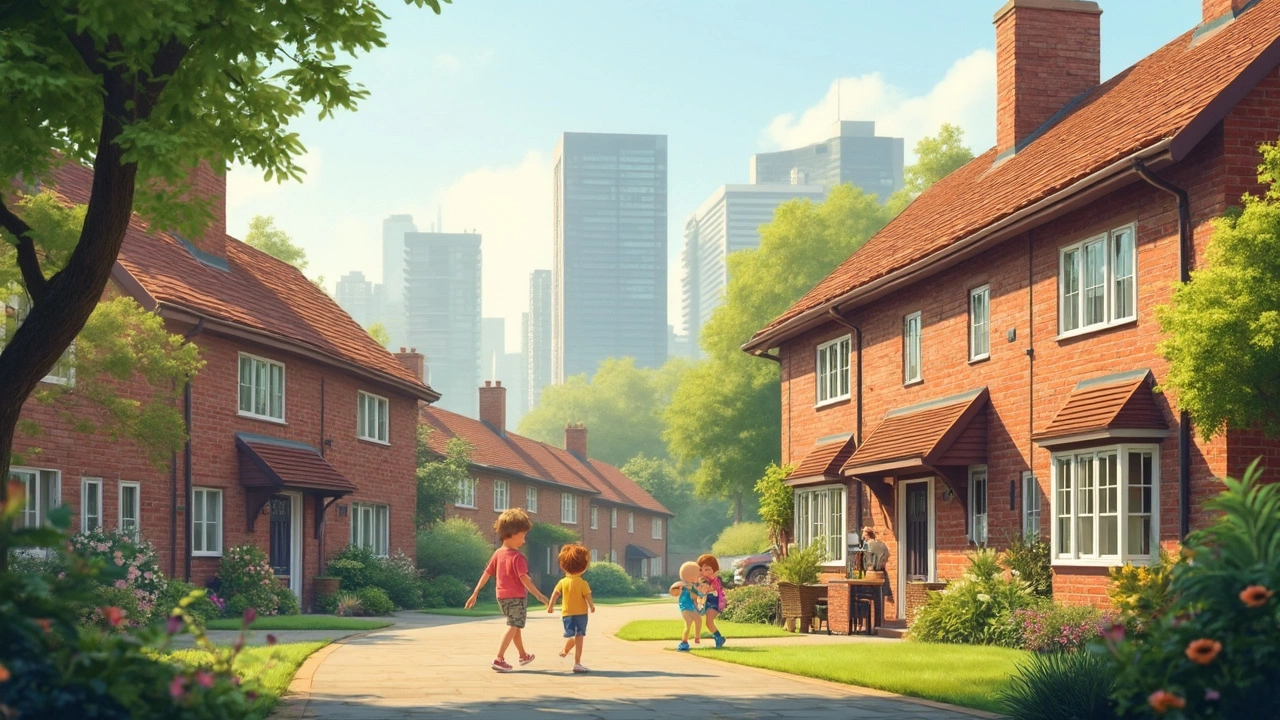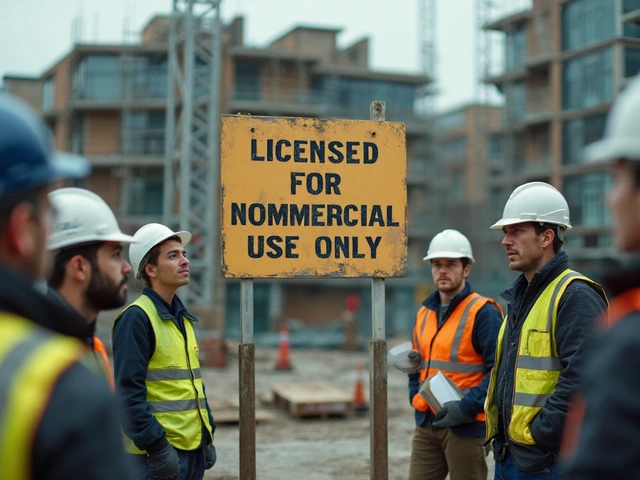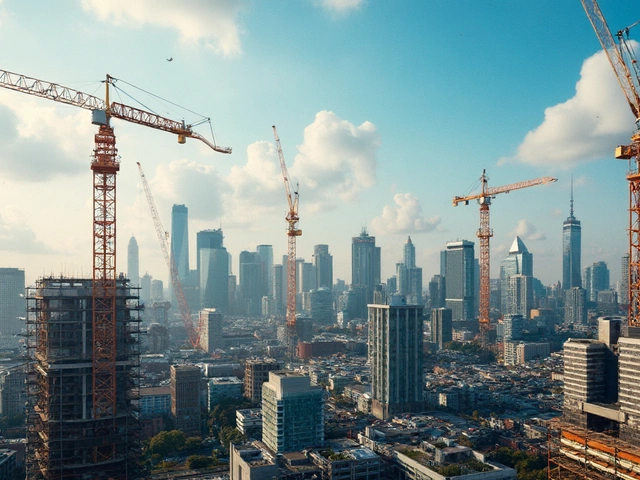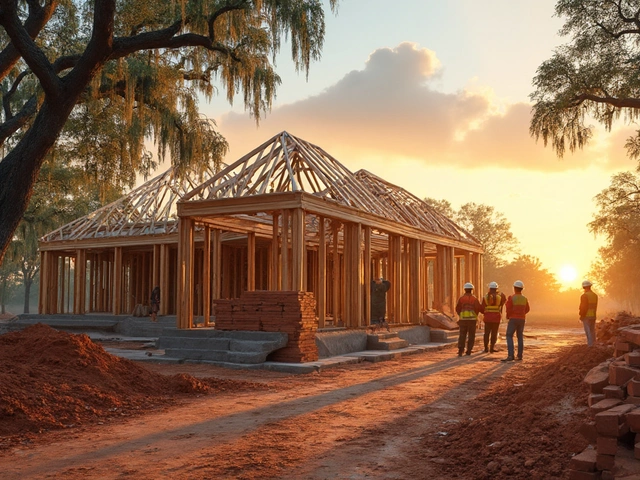If you think every construction project is the same, you’re in for a surprise. Most folks know about commercial construction—think malls, office buildings, and hotels. But what if you’re not building for business?
The clear opposite is residential construction. That’s all about homes, apartments, and sometimes even tiny houses on wheels. Whether you’re planning your dream home or just curious about the process, it makes a big difference to know if a project is residential or commercial. Rules, permits, and even the type of workers involved can all be wildly different.
If you’re weighing your options or trying to make sense of all the industry talk, knowing what makes residential the “opposite” of commercial can help you avoid expensive mistakes. Plus, if you ever think about building or remodeling on your own property, you’ll want to understand these basics first. Trust me, it makes life easier for homeowners and DIY lovers alike.
- Commercial Construction: A Quick Refresher
- What Counts as the Opposite?
- Residential Construction Explained
- Key Differences You Should Know
- Other Types You Might Not Expect
- Tips for Choosing the Right Builder
Commercial Construction: A Quick Refresher
So, what’s the big deal with commercial construction? In simple terms, it’s all about building spaces for business. We’re talking about places like shopping centers, hotels, restaurants, warehouses, offices, and even schools. If money changes hands in that building, there’s a good chance it’s commercial.
These projects are usually a lot bigger and more complicated than throwing up a basic house. Just think about the HVAC systems, elevators, fire alarms, and parking structures. Safety codes and zoning laws are way stricter too. Cities care a lot about how these places are built since a lot of people move through them every day.
It’s not just about the size or number of stories. Commercial jobs often need:
- Detailed blueprints and architectural plans
- Special permits from local governments
- Coordination with lots of subcontractors (plumbing, electrical, HVAC, roofing—the works)
- Days or weeks of inspections at different stages
Another thing—Financing on these projects usually comes from banks, investment groups, or even government grants. That means more paperwork and a longer timeline. According to a 2023 industry report, the average cost per square foot for new office buildings in the U.S. was around $250 to $400. For a hospital or data center, it can shoot past $600 per square foot.
| Project Type | Average Cost per Sq. Ft. (2023) |
|---|---|
| Office Building | $250-$400 |
| Retail Space | $200-$350 |
| Hospital | $500-$700 |
The bottom line: Commercial projects are built to handle crowds, strict laws, and high demands. They need a different kind of planning, crew, and budget than you’d ever use for a regular house.
What Counts as the Opposite?
When someone asks about the opposite of commercial construction, they're basically talking about jobs that aren't focused on businesses or big public spaces. The most common answer is residential construction. This covers projects where people actually live—think houses, condos, apartment buildings, and sometimes even dorms or retirement homes. If the main goal of a building is to provide a home, that's residential, plain and simple.
But it's not just about the types of buildings. It's also about who the construction serves and how it's used. Commercial jobs cater to companies, organizations, or the public. Residential jobs serve private families or individuals. Owners, financing, and project goals are usually very different.
- Residential Construction: Single-family homes, duplexes, townhouses, apartment complexes.
- Mixed-Use (with mostly residential): Some buildings have shops on the first floor but apartments above. If most of the space is residential, it still usually counts as the "opposite" of commercial.
- Private, Non-Profit Spaces: Places built not for profit, like some hospitals, churches, or community centers, can sometimes blur the lines, especially in small towns.
If you're unsure which side a project falls on, try asking: Is this building mainly meant for someone to live in, not to sell anything or run a business? If the answer is yes, odds are it's the opposite of commercial construction.
Check out this quick table for a clear breakdown:
| Type | Main Use | Who Uses It |
|---|---|---|
| Commercial | Offices, Retail, Warehouses | Business/Public |
| Residential | Homes, Apartments | Individuals/Families |
This distinction matters for everything from building codes to insurance. Making the right call early on saves you stress—and possibly a ton of cash—down the road.
Residential Construction Explained
When you hear the term residential construction, think houses, condos, townhomes, and apartment buildings. These projects are all about where people live, not where they work or shop. It covers everything from single-family homes in the suburbs to high-rise apartments in the city.
Most residential builds, especially single-family homes, come with a whole different set of rules and standards compared to commercial construction. You’ll see things like local building codes, homeowner association guidelines, and energy efficiency requirements. For example, while commercial projects may have to follow strict fire safety systems for businesses, homes are designed more for comfort, easy living, and family needs.
Check out some of the most common types of residential construction projects:
- Single-family homes (your everyday houses)
- Townhouses and duplexes
- Apartment complexes
- Condominiums
- Mobile and modular homes
Did you know about 60% of all building permits in the U.S. go to residential projects? That should give you a sense of just how big the field is. The labor is usually more specialized for comfort and fit, focusing on plumbing, electrical, insulation, and interiors that make a home feel… well, homey. If you're looking to save on energy, residential codes now push for things like thicker insulation or smart heating systems—stuff you usually won’t see in a shopping mall.
Another big thing is timelines and budgets. Residential jobs tend to move faster and have tighter budgets than commercial ones. Projects like home remodels or new builds often finish in months, not years.
Main point? If the end goal is a place to live, not do business, you’re talking residential construction. And if you’re ever planning a project like this, working with a builder who knows the ropes here is a huge help. One slip-up on a local code or permit can slow things down fast, so local experience really matters.

Key Differences You Should Know
If you line up commercial construction and residential construction side by side, the differences stand out fast. Let’s get right to the real stuff people overlook.
Commercial projects are made for business—think shopping centers, offices, big warehouses. These jobs are usually bigger, cost more, and need special permits that a home wouldn’t. On the other hand, residential construction focuses on places people live: single-family homes, duplexes, or apartment buildings up to a certain size.
- Permitting and Codes: Commercial construction has stricter zoning rules, way more fire safety features, and tougher accessibility requirements. Residential rules are still important, but they don’t go as deep, especially around things like emergency exits and elevator installs.
- Design and Engineering: Commercial buildings need strong foundations and steel frames to handle crowds and heavy equipment. Residential homes usually go with wood framing and simpler layouts. That means the engineering team is bigger and pricier on commercial jobs.
- Timeline and Budget: Commercial jobs take longer and cost way more, not just for building, but for planning, safety checks, and inspections. Home projects move faster—sometimes a new house can go up in just a few months if permits don’t drag.
- Contractors and Specialties: You’ll find bigger teams on commercial sites, often split by specialty—like HVAC, security, roofing. On a home, you might just have a general contractor with a few subs.
Check out this side-by-side for a quick idea:
| Feature | Commercial Construction | Residential Construction |
|---|---|---|
| Main Purpose | Business operations | Living space |
| Permitting | Strict, complex | Simpler, local codes |
| Materials | Steel, reinforced concrete | Wood, basic concrete |
| Project Length | Months to years | Weeks to months |
| Team Size | Large, specialized | Smaller, general |
The bottom line is, commercial and residential projects follow different rules, have their own timelines, and need their own kind of experts. Knowing these differences helps you ask the right questions if you need to hire someone or jump into building yourself.
Other Types You Might Not Expect
When you think about the opposite of commercial construction, your mind jumps right to houses and condos. But there’s a few more types out there that don’t fit neatly in the residential or business bucket.
Let’s break down a few less obvious examples:
- Institutional Construction: Think schools, churches, universities, and public hospitals. They aren’t built for profit like offices or shops, but they’re not residential either. The building codes and even the materials are different, plus there’s usually more red tape if public funds are involved.
- Industrial Construction: Factories, plants, and massive warehouses fit here. These places often get confused with commercial buildings, but they’re for making things, not selling or living. Fun fact: industrial sites usually need specialized builders since they deal with heavy equipment and strict safety rules.
- Agricultural Construction: Barns, greenhouses, and grain silos count too. These rarely enter city conversations, but if you’re in farming communities, this is everyday stuff. And yes, agricultural building codes are a different animal.
Here’s a quick comparison to put all this in perspective:
| Type | Main Purpose | Common Examples |
|---|---|---|
| Residential | Living Spaces | Single-family homes, condos, apartments |
| Institutional | Public/Community Use | Churches, schools, courthouses |
| Industrial | Manufacturing/Production | Factories, warehouses, power plants |
| Agricultural | Farming Operations | Barns, stables, greenhouses |
Each of these types has its own rules, standards, and quirks. If you ever need to manage one of these projects, don’t assume they work the same as commercial construction. Ask pros who know those specific spaces—mistakes can cost big time.
Tips for Choosing the Right Builder
Picking the right builder can stop headaches before they start. Whether it’s a commercial construction project or your own home, the decision can make or break the process. Here’s what actually matters.
- Check Past Work – Look at finished projects, not just pictures on their website. Visit a job site or ask to talk to old clients. Reputable builders have nothing to hide.
- Licenses and Insurance – Don’t skip this step. Licensed and insured contractors protect you if things go wrong. In the U.S., every state lets you look up licenses online.
- Experience With Your Project Type – There’s a real difference between a team that’s built office towers and one that specializes in homes. You want the right kind of experience—ask if they’ve handled jobs like yours before.
- Get Detailed Quotes – A clear quote spells out everything: labor, materials, time frames, and payment plans. If it's fuzzy, ask for more clarity. Watch for hidden fees.
- Communication Matters – Choose builders who respond fast and explain things simply. If they ignore your calls now, it won’t get better once the project starts.
If you’re tackling something big, like a residential construction build or converting a property, it pays to dig into the details. Here’s a quick look at contractor stats:
| Factor | What Homeowners Say |
|---|---|
| Top regret | Not checking references (54%) |
| Biggest cost surprise | Lack of detailed quote (47%) |
| Main reason for delays | Poor communication (62%) |
Finally, check online reviews but don’t rely just on them. Ask real people for recommendations. Your neighbors and friends usually know who to trust—or avoid—when it comes to building types in your area.





